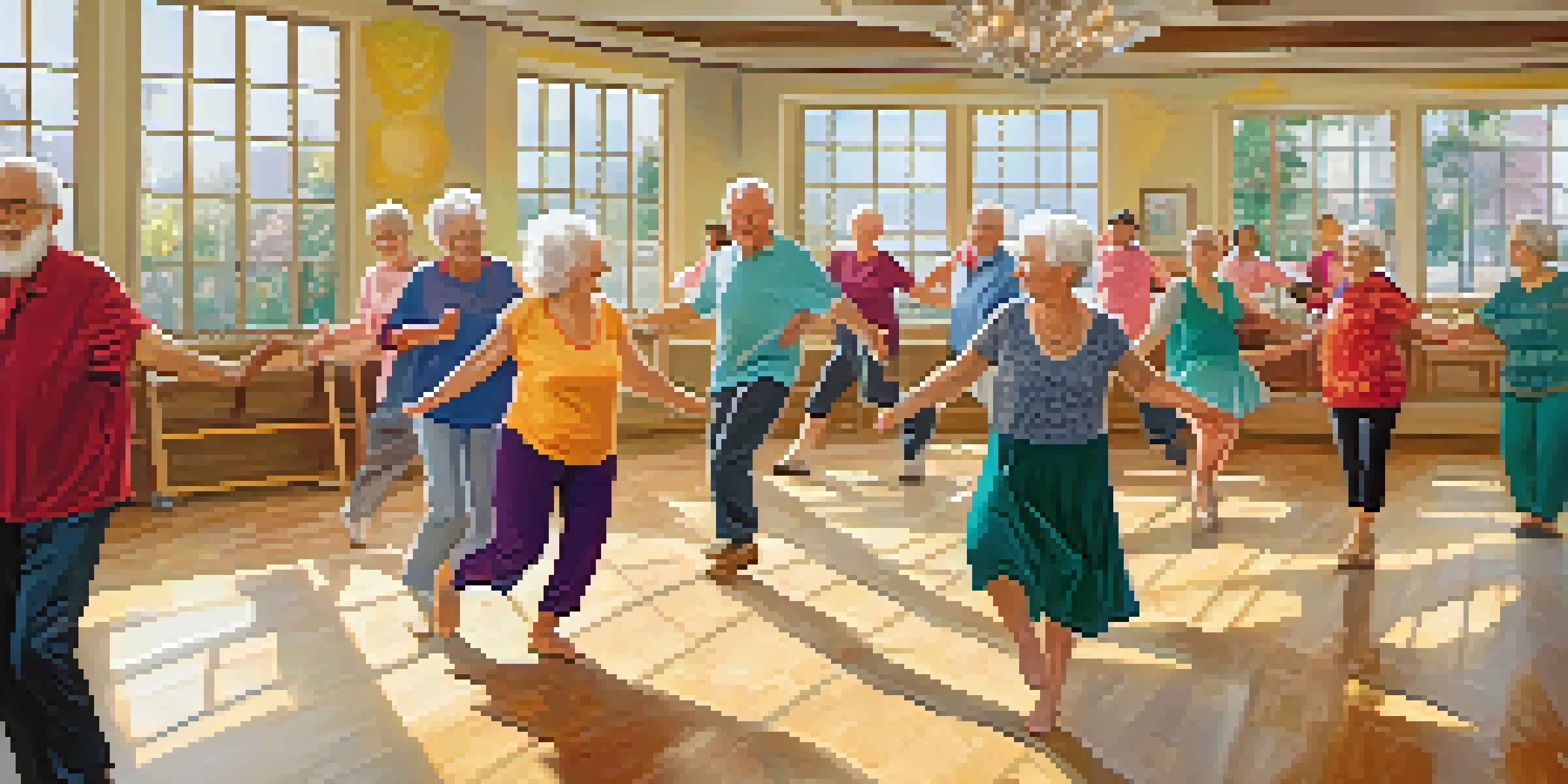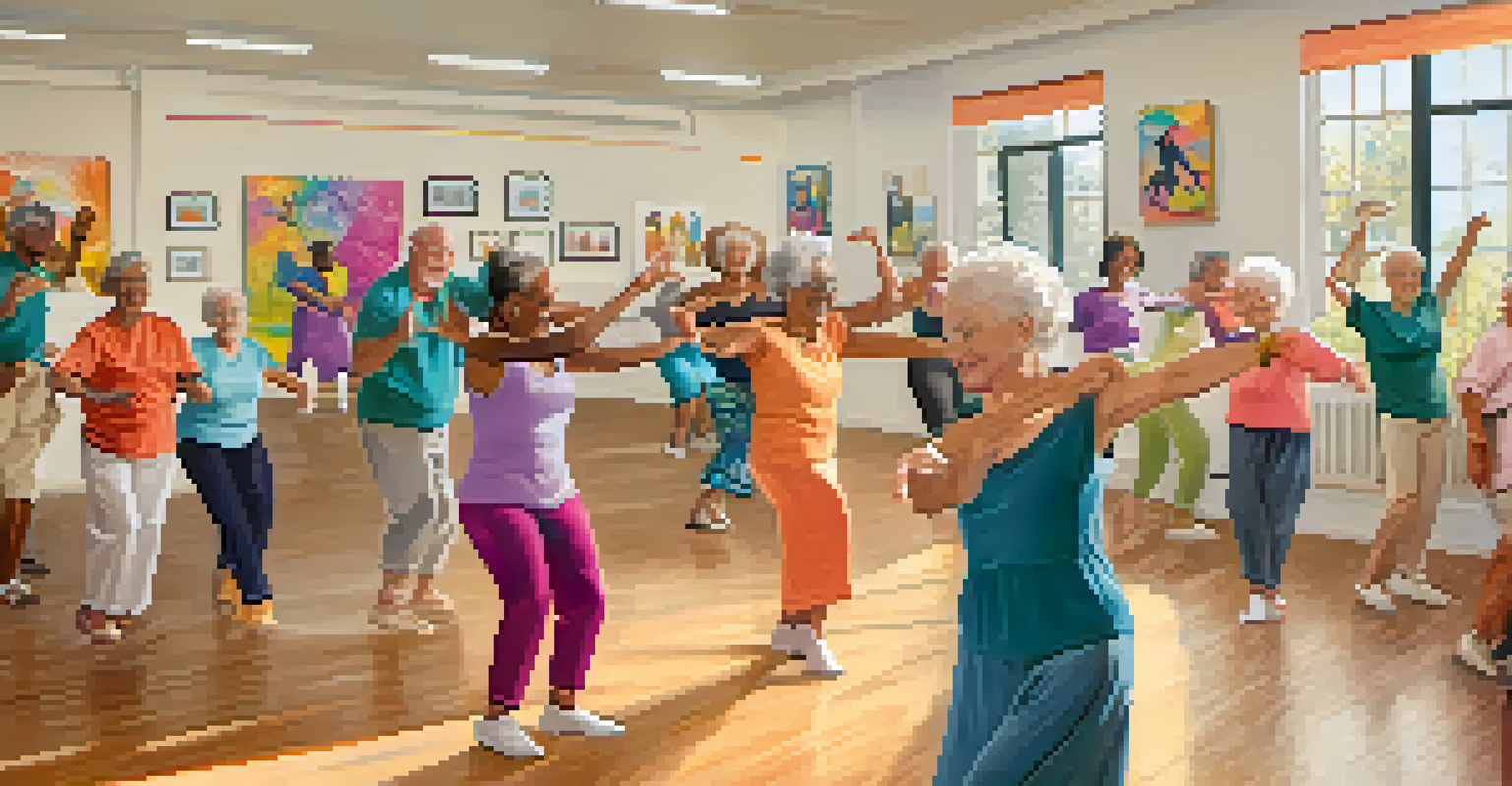Dance as Therapy: Enhancing Quality of Life for Seniors

Understanding Dance Therapy and Its Benefits
Dance therapy is a creative approach that combines movement with emotional expression. It helps seniors connect with their feelings and experiences in a joyful way. By engaging in dance, participants can foster both physical and mental well-being, making it a powerful tool for enhancing quality of life.
Dance is the hidden language of the soul.
Not only does dance therapy provide a fun outlet for creativity, but it also encourages social interaction. Seniors often find that group dance sessions build camaraderie, reducing feelings of loneliness. This sense of community is crucial in maintaining mental health as we age.
Moreover, the physical benefits are significant. Dancing enhances flexibility, balance, and coordination, which are essential for seniors. These improvements can lead to a greater sense of independence and confidence in daily activities.
The Role of Movement in Emotional Expression
Movement is a universal language that transcends words, making it especially effective for seniors who may struggle with verbal communication. Dance allows for an outlet of feelings that might otherwise remain bottled up. This form of expression can lead to emotional release and relief from stress.

Consider the example of someone who has lost a loved one. Through dance, they might express their grief in a way that feels safe and healing. This connection to emotions through movement can be profoundly therapeutic, encouraging individuals to process their feelings.
Dance Therapy Enhances Well-Being
Engaging in dance therapy fosters physical, emotional, and social well-being for seniors.
Additionally, research shows that physical activity can boost mood by releasing endorphins. When seniors participate in dance therapy, they not only express emotions but also experience a natural mood lift, creating a positive feedback loop of well-being.
Social Benefits of Dance for Seniors
Social connections are vital for seniors, and dance therapy provides a perfect platform for building relationships. Group classes foster a sense of belonging, which can combat feelings of isolation. Seniors often find joy in shared experiences, creating lasting friendships through their love of dance.
Movement is a medicine for creating change in a person's physical, emotional, and mental states.
Imagine a senior center filled with laughter and music as participants twirl and sway together. This vibrant atmosphere encourages interaction, breaking down barriers and promoting inclusivity. The shared joy of dancing can strengthen bonds and create new social circles.
Moreover, engaging in social activities like dance can lead to improved cognitive function. As seniors learn new steps and routines, they stimulate their minds, keeping their brains active and engaged. This dual benefit of socialization and cognitive exercise is invaluable for overall well-being.
Physical Health Improvements Through Dance
Dance is not just fun—it's a fantastic way to enhance physical health. Regular movement helps improve cardiovascular health, strengthens muscles, and increases endurance. For seniors, these benefits are crucial for maintaining mobility and independence.
Consider a senior who joins a weekly dance class. Over time, they may notice improved stamina and greater ease in everyday activities like walking or climbing stairs. This physical enhancement can lead to a more active lifestyle, empowering seniors to engage more fully with their communities.
Movement Aids Emotional Expression
Dance serves as a powerful outlet for seniors to express feelings that might otherwise remain unspoken.
Furthermore, dance can be tailored to meet individual abilities, ensuring that everyone can participate safely. Whether it's gentle stretching or more vigorous routines, there's a form of dance suitable for every senior, making it an accessible health option.
Cognitive Benefits of Dance Therapy
Engaging in dance can significantly boost cognitive function in seniors. Learning choreography and remembering dance sequences stimulate the brain, promoting neuroplasticity—the brain's ability to adapt and grow. This can be particularly beneficial for seniors at risk of cognitive decline.
For instance, a senior learning a new dance style might find that their memory improves as they practice. This mental engagement can lead to sharper focus and better problem-solving skills, contributing to overall cognitive health.
Additionally, the rhythm and coordination involved in dance challenge the brain in unique ways. As seniors navigate movement patterns, they enhance their spatial awareness and improve their reaction times, leading to a more agile mind and body.
Creating an Inclusive Dance Environment
An inclusive dance environment is essential for maximizing the benefits of dance therapy for seniors. This means providing options that cater to various abilities and preferences, ensuring everyone feels welcome. Classes should be designed with accessibility in mind, using adaptive techniques when necessary.
For example, a dance class might incorporate seated options for those with mobility challenges, allowing them to participate fully. This adaptability fosters a sense of belonging, encouraging seniors to express themselves without fear of judgment.
Builds Connections Among Seniors
Group dance sessions create a sense of community, combating loneliness and promoting social bonds.
Moreover, instructors should be trained in working with seniors to create a supportive atmosphere. When seniors feel understood and valued, they are more likely to engage enthusiastically, leading to a richer therapeutic experience.
Integrating Dance Therapy into Senior Care
Integrating dance therapy into senior care programs can transform the quality of life for residents. Care facilities that include dance therapy notice a marked improvement in residents' mood and overall engagement. This integration creates a holistic approach to senior care, addressing both physical and emotional needs.
Consider a nursing home that schedules regular dance sessions. Residents eagerly anticipate these classes, often sharing stories and laughter while they move. This not only enhances their physical health but also cultivates a joyful community spirit.

Incorporating dance therapy into care routines can also provide caregivers with a valuable tool for building rapport with seniors. Through dance, caregivers can connect on a more personal level, enhancing the trust and bond that are critical in caregiving.